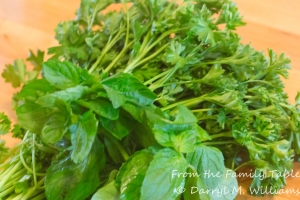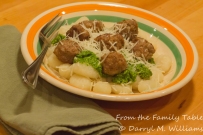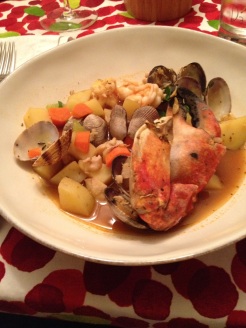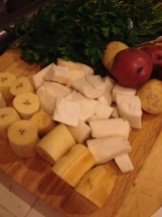This is the time of year when you can find Meyer lemons in abundance in California, especially in the Bay Area. They are delicious and very different from the usual Eureka lemons you find in the grocery store. At their best, Meyer lemons are large, nearly the size of oranges, and a beautiful golden-yellow color richer than store-bought lemons. They have a citrus smell that seems like a cross between lemon and orange, and they are sweeter than Eureka lemons, though not so sweet that you would eat one out of hand.
With the abundance and special qualities of Meyer lemons, California chefs – and even those in Santa Fe – go crazy with Meyer lemon curd, Meyer lemon pie, Meyer lemon cake – you get the idea.
On our recent trip to San Francisco, I found some beautiful Meyer lemons at the Marin Farmers’ Market in San Rafael. I bought a couple of pounds, and brought them home in my checked bag. I didn’t have any specific plans for them, so I leafed through some of my new Christmas-gift cookbooks from the Bay Area. Thomas McNaughton, chef at Flour+Water, had an interesting recipe for preserved Meyer lemons in his book, so I thought I would give that a try.
I followed McNaughton’s recipe (sort of) with the plan of making a gallon of preserved lemons. I had to buy a gallon-size glass jar, and unfortunately I wound up not having enough Meyer lemons. I found some at our local Whole Foods, offered in little net sacks. The lemons were literally a pale comparison with my California beauties. They were yellow, small, and blemished with soft spots. Still, I bought them, and wound up needing about 7 pounds of Meyer lemons in total to complete the recipe.
Preserved lemons are a tradition in the cuisines of North Africa. The basic preservation method is brining, so most cooks wind up not using the flesh or juice, but just the peels, finely cut, to provide a citrusy taste to many things including meats and stews. (there are some recipes for using the flesh, but it must be incredibly salty.) Cookbooks provide an abundance of methods for preserving lemons. Sandor Katz describes the basics in his encyclopedic, The Art of Fermentation and Deborah Madison gives a simple recipe in Vegetarian Cooking for Everyone.
McNaughton’s recipe calls for way more salt than I used. Even at that, the undissolved salt sits at the bottom of my jar of lemons as they preserve away in the coolness of the garage. Sugar and spices make McNaughton’s recipe unique, and I followed his guidance.
RECIPE
Preserved Meyer Lemons
Ingredients
- 7 pounds large Meyer lemons
- 6 cups pickling and canning salt
- 2 cups sugar
- 2 pieces star anise, broken into smaller pieces
- 1 teaspoon fennel seeds
- 1 teaspoon coriander seeds
- 1 teaspoon whole black peppercorns
- 2 teaspoons red pepper flakes
- 2 large bay leaves, crumbled
Method
- Sterilize a 1-gallon glass container with non-reactive lid by boiling in water for 10 minutes or washing in dishwasher set on hot.
- Wash and dry the lemons.
- In a large bowl, combine the salt, sugar, and spices.
- Prepare the lemons by slicing them in half from the pointed end to the stem end, stopping ½ inch from the base. Turn the lemon one-quarter turn, and make a similar cut so that each lemon has four quarters joined together by the uncut portion.
- Pour ¼ inch of salt-sugar mixture into the bottom of the glass jar.
- With a tablespoon, sprinkle a heaping tablespoon of the salt sugar mixture into the cut lemons, one by one, and then arrange them, cut-side up, in the jar. Pack tightly.
- When you have a layer of lemons packed in the jar, sprinkle more of the salt-sugar mixture on the top, pressing down with a potato masher to express as much juice as possible.
- Layer by layer, continue packing the jar with prepared lemons and adding a layer of salt-sugar mixture on top of each layer. Continue to press down each layer with the potato masher. Top the lemons with more salt-sugar mixture, seal the jar, and set it aside for 48 hours.
- At that time, add more salt-sugar mixture and, if necessary, lemon juice so that the lemons are completely covered. Seal the jar tightly and set in a cool, dark place for three months.
- When the lemons have been completely preserved, store them in the refrigerator for up to a year.
Notes
- Other recipes call for less salt, and I think you could cut back on the salt.
- Use pickling and canning salt. Regular table salt may leave a residue from the anti-caking agent that is used.
- The lemons must be completely covered with liquid, otherwise they are likely to spoil.
- Use tongs when removing lemons for use. Hands, no matter how clean, may introduce organisms that can lead to spoiling.
- Rinse the lemons well before use, as they will be quite salty. Use the rind and discard the flesh – unless of course you want to experiment with it.










































































